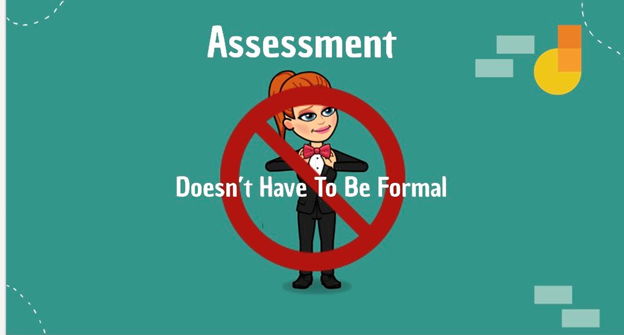What does and doesn’t work in assessing your students during remote learning
Rethinking Your Approach
Open book, open internet, open notes, and open peer assessments! Does the thought of this bring chills down your spine? For some those chills are of deep concern and rejection. But for some, this brings chills of excitement and intrigue! Whether your classroom is remote or a hybrid blended learning environment, it may be time to adjust your approach to assessments.
What does Assessing Mean?
Before we try to assess a student, we need to ask “What is the purpose?” and “What is the learning?” (Cori Orlando and Janet Sewell) To answer those, we need to focus on the three components of assessing: Standards, Application, and the Assessment.
The lessons should be based on the Standards and the academic needs of the students. Designing backwards from the standards is more important than ever when face-to-face teaching time is such a rare resource. Have clear and measurable goals that are aligned with the appropriate standard.
The question, “What is the Learning?” is answered through the Application, which is evidence of the student’s use of the skill or knowledge. How can they demonstrate mastery? Do they need to do it in a traditional formal or summative assessments? Can they show it in some other assignment or project? A video presentation? A group discussion? A drawing? The answer to this question leads us to what our assessment actually should look like and what is the measurable learning by the student.
The Assessment is about identifying what they have learned and not just giving a student a score or grade. What matters most is that you get an accurate picture of a student’s abilities, not how you get that picture.
Keep in mind that good teaching is still good teaching. Best teaching practices are still all about setting high expectations. Many teachers I’ve spoken with have stated that this feels like their first year of teaching all over again. However, unless it really is your first year, you already have the skills and experience to help you. Your students and their families are counting on us to guide this path of education and it starts with how we assess, what we assess, and why we are assessing.

Assessing Students: What Doesn’t Work Anymore?
The answer: plenty. Many of the traditional assessments just don’t work in this new environment. At the core of this is the issue that we are not getting accurate data on student learning.
One of the main factors is, as seasoned teacher Angela states, “What isn’t working are parents with limited tech skills projecting a negative attitude onto our kids. They can do so much if some of the adults will step out of the way and let them learn by doing, and by using a growth mindset.”
Another veteran teacher, Kristal, expresses her concerns, “Because I am working with first graders, their parents are very involved and helpful. However, that means that I am unable to assign assessments through Seesaw or any other avenue as independent work, as I know many will get too much help to make it valid data.”
One of the most challenging subjects to assess accurately in a remote learning environment is writing. Typically, the writing component was the ultimate and final assessment that put everything together. However, since it is difficult to monitor the students because they may be getting additional help at home and often do not leave their cameras on even during live assessments, the data from these assessments are skewed and unreliable.
The distractions of the home, the inconsistency of internet service, website use and availability, and even the challenge of learning new online programs all contribute to what does not work when assessing students remotely. Traditional assessments just aren’t as valid as they would be in the classroom.

Graphic by Cori Orlando and Janet Sewell
Assessing Students: What Still Works?
The answer to this question is also plenty! After posing this to educators in all elementary grade levels, administrators, and district support staff, the number one assessment that still works is one-on-one. It is the most time consuming but it provides a clearer picture of what the student knows and can apply.
Whether it is for formal assessments such as DIBELS or Running Records, one-on-one can also be used for informal assessment by just having conversations with the student and asking key leading questions to see if they can apply the skills that were taught and (ideally) learned.
One teacher told me that instead of small group time, she set up brief one-on-one appointments with her students to do informal and formal check-ins. These five-ten minute sessions provide her with more real data than all of her weekly SeeSaw submissions.
A recently retired teacher and current keynote speaker at local and national conferences, Steve Morris states, “For formative assessments (no grade attached), I still use @GetKahoot, @quizizz, and @gimkit. All three give valuable data that helps inform my instruction.” In addition to the ones Steve lists, there is also PearDeck, Seesaw, Nearpod, GoFormative, and of course, ReadTheory.
Principal, author, podcast host, and pioneer with technology in the classroom, Brent Coley suggests, “Breakout rooms have been a great way to get students more engaged. It’s tough to sit and stay on mute for extended periods of time, so breakout rooms give students the opportunity to interact more.” With better engagement and by monitoring these breakout rooms, a teacher can make informal assessments. One suggestion is to keep anecdotal notes during these sessions that could be used for grades or scores.
Fifth-grade teacher, Maria Phillips provides a list of what works for her:
- Assessment through observations of students
- Oral assessments
- Online whiteboards/physical whiteboards to assess students understanding
- Online assessments with cameras on
- Flipgrid allows students to demonstrate understanding
- Quick checks/Exit Tickets

Graphic by Cori Orlando and Janet Sewell
Doesn’t Have to Be Formal
Although the challenges of assessing in remote and hybrid learning are many and frustrating, this is an incredible opportunity to try new approaches and eliminate antiquated assessments. If the ultimate goal is to identify student learning and growth, then it does not need to be a specific type of assessment.
Adjusting our approach and focus will guide us to recognizing and accepting what is and what could be considered an assessment. Assessments do not all have to be formal. They do not need to be extensive. Assessing a student does not need to be a test but could be the application of the skill or standard. As educators our goal or mission is to prepare students for college and career readiness. If we follow that line of thinking, then let’s provide a path for students to be assessed accordingly.
Beyond the formal and informal assessments suggested above, what if we assessed by:
- Providing all the information with open books and open internet
- Encouraging collaboration
- Encouraging students to seek help from a mentor or teacher
Then we would truly get an assessment based on the application of what they learned and not just a rote regurgitation of patterns and temporary memorization. Of course this would be more challenging at the primary grades, but it could be something that is guided and practiced for future grades and life skills.
Let us know what works for you with remote and hybrid learning!
For more in-depth articles on remote and hybrid assessments, check out these great resources:
* Cover photo by Cori Orlando



